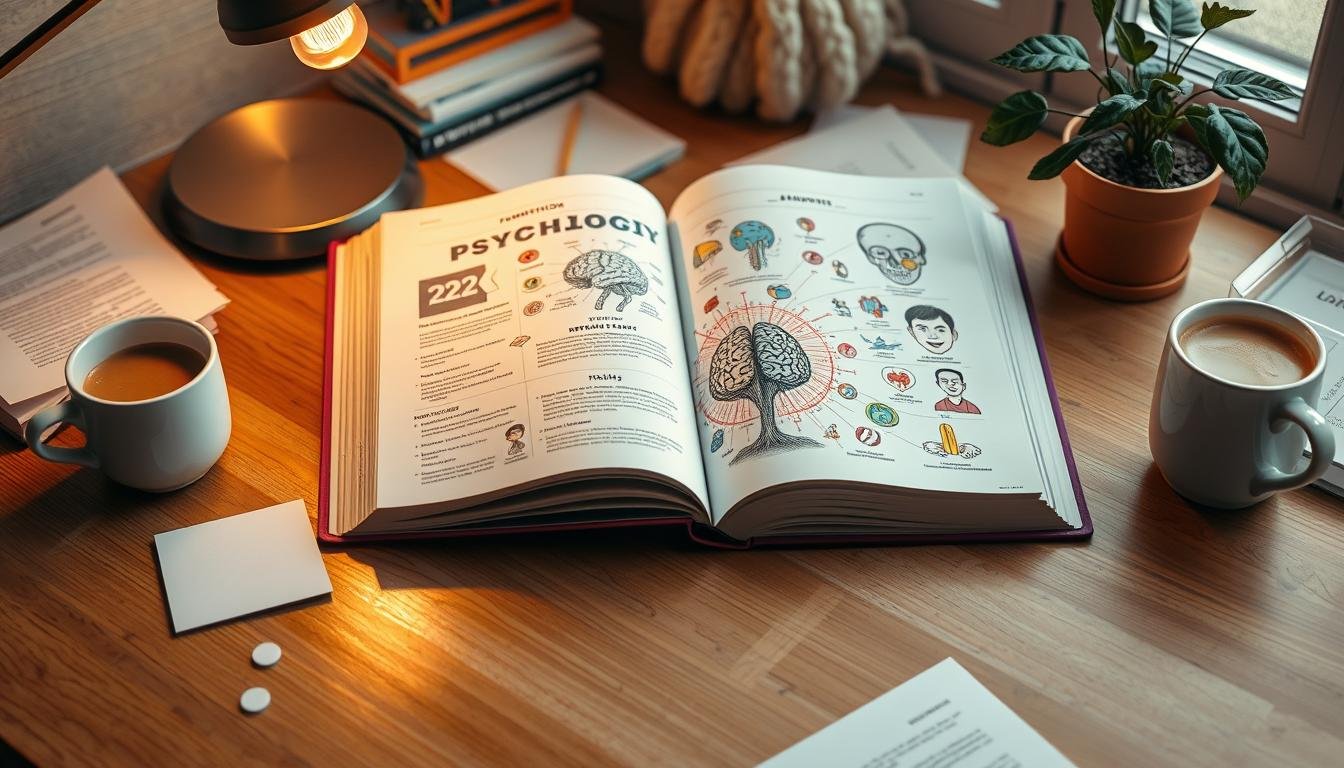

The psychology textbook, “Discover Psychology” by Susan Nolan, has reached its 9th edition. It remains crucial for both students and teachers. This edition dives deep into human behavior and how our minds work. It includes up-to-date information and recent scientific findings.
A new chapter on Gender and Sexuality has been added. The effects of COVID-19 are also discussed more. The textbook is easy to use on mobile devices. It works well with the Achieve platform, which helps students learn with quizzes, feedback, and setting goals.
This edition combines old teaching methods with new technology in a smart way. It gives psychological knowledge in a more accessible format. This makes it a must-have for those interested in psychology.
Table of Contents
ToggleKey Takeaways
- The 9th edition features updates and new chapters, such as Gender and Sexuality.
- Expanded coverage of COVID-19’s impact on mental health is included.
- The mobile-friendly design enhances accessibility.
- Integration with the Achieve platform adds interactive learning tools.
- Updated research and developments give a comprehensive view of psychological knowledge.
Introduction and Research Methods
“Discover Psychology 9th Ed by Susan Nolan” begins with basic psychology principles. It shows how research methods are crucial. Readers learn the importance of collecting, analyzing, and understanding data.
Research methods are key in psychology. They help explore and make sense of human behavior.
Why Research Methods Matter
It’s vital to grasp research methods in psychology. They aid in designing experiments, interpreting results, and checking if findings can be repeated. Knowing scientific literacy allows for a better evaluation of study quality and relevance. This ties back to basic psychology, creating a strong support for the field.
Key Research Methods in Psychology
Psychology studies rely on various research methods:
- Experimental Research: It looks at how changing one thing can affect another, establishing cause-and-effect.
- Correlational Research: This identifies connections between two things but doesn’t prove one causes the other.
- Descriptive Research: Using case studies and surveys, it describes behavior without altering it.
Including diverse groups in studies shows different cultural views, essential for full research. It also builds scientific literacy, making it easier to scrutinize these studies and understand their impact.
Check out Editorial Fox for more exciting reads and in-depth analyses1.
Neuroscience and Behavior
Neuroscience and behavior studies show how our brain works and reveal the mind’s mysteries. These studies show us how the brain’s workings affect how we act, think, and feel. They give us important knowledge about our thinking and emotions.
The Brain’s Hidden Treasures
The brain’s complex networks of neurons hold many secrets. Since the mid-20th century, neuropsychological tests have helped diagnose and treat brain issues2. Tools like Psicosmart now let experts do tests with great accuracy2. This shows how blending technology with neuroscience leads to better understanding and tests for different jobs2.
Brain scans and theories help create better assessments. This aligns with our brain’s natural workings, improving diagnosis and treatments2.
Behavioral Insights from Neuroscience
Neuroscience gives us deep insights into psychological conditions. Using scans like fMRI and PET, psychologists can see our thinking and feelings in action. This greatly improves our grasp of mental health issues2.
This mix of scanning and testing gives a full view of the mind2. It also leads to targeted help, such as therapy and mindfulness, based on brain scan data2.
Almost 90% of drug trials in humans fail, shifting focus to imaging and new methods3. The NIMH’s plan from 2008 shows this change3. This marks not just scientific advances but also our growing understanding of the brain and behavior.
Education benefits too, with tools like Psicosmart creating tests for students’ unique brains, improving how we teach2. AI in testing makes it easier to evaluate students’ skills more personally2. These insights from neuroscience are like finding a treasure in understanding our minds, promising more discoveries ahead.
Sensation and Perception
In the dynamic realm of psychology, sensation and perception are key areas. They explain how we process and understand sensory information. This knowledge helps us see how we turn what we see, hear, and feel into clear mental pictures.

Understanding Sensory Processes
Our senses pick up information from around us. This data travels through a network of neurons to our brain. Here, it enables us to think and react to our surroundings. Our sensory receptors identify stimuli like light and sound and change them into signals our brain can understand.
How Perception Unfolds in the Mind
Our brain works to make sense of all the sensory information. It combines, sorts, and explains these signals to help us understand the world. For example, in role-playing games, passive perception lets players notice small details. They might catch a faint smell or see a small part of an orc hiding4.
Active perception, on the other hand, is when players search for something specific. They might look for hidden items, secret doors, or traps4.
Learning
Exploring behavioral psychology opens up a world of learning theories. These theories explain how we learn new things. They cover both classical and operant conditioning, showing us how behaviors and skills form.
We start with classical conditioning, introduced by Ivan Pavlov. This idea tells us a neutral signal can lead to a learned response if paired with another stimulus. Then, there’s B.F. Skinner’s operant conditioning. It shows that actions are influenced by rewards or punishments, stressing outcomes’ roles in learning.
Albert Bandura’s social learning theory adds another layer. It suggests we learn by watching others. This concept highlights the power of copying and role models in learning, extending beyond direct experiences.
The chapter offers real-life examples to show these theories at work. For example, it looks at how learning to tell one stimulus from another affects outcomes. This not only shows how learning works but also its effects on society.
There are fun activities and case studies too. Like a treasure hunt exercise for kids, which uses observational learning5. They find treasures with hints and environmental cues, showing learning through interaction.
It then discusses how our brains play a part in learning, tying it to behavioral psychology. It dives into cognitive learning theories, which show how focusing, remembering, and wanting help us learn alongside conditioning.
In the end, we see a full picture of how learning happens. Combining old and new ideas gives readers deep insights into learning’s complex nature.
Memory: Unlocking the Mind’s Treasure Chest
We dive into how our minds keep, reach, and use key info by exploring memory. It’s key to understand memory models to get the full picture.
Mechanisms of Memory
Memory works through encoding, keeping, and getting back info. First, encoding changes info so we can store it. Then, we keep it for future use. Lastly, we get it back when we need it. Models of memory help us see how this happens. Like in Krakow, Poland, during tough times, people hid valuables in chests. This shows how we keep and find back special memories when things are hard6.
Enhancing Memory Retention
Making memory better is key for holding onto info. Tools like mind tricks, seeing images in our heads, and repeating stuff help. Also, using what we learn from memory in real life matters. In Krakow, finding treasures made kids excited. This excitement helps us hold onto memories when we feel a personal link6.
Feeling the joy of discovering treasures helps our brain work better, just like memory models suggest6. Using emotion-packed methods makes memories stick. This shows why feelings are so important in making memories last7. Using these ideas every day can help us and our communities a lot.
Thinking, Language, and Intelligence
The connection between thinking, language, and intelligence is key to understanding how we grow mentally. We look at how language forms and different theories about intelligence.
The Role of Language in Cognitive Processes
Learning language is vital for mental growth. At schools like Ramalynn, kids interact with writing before age six, boosting their mental skills8. They often start writing before reading, diving into language early on8. Before kindergarten, they grasp complex language parts like nouns and verbs8. Early learning shapes their minds through practice and active participation8.

AI in writing shows how language can shape thinking. These tools have grown better and more popular, even outdoing human creativity at times9. Some AI can summarize complex ideas quickly, showing their impact on learning and language9.
Exploring Measures of Intelligence
Talking about intelligence is always evolving and debated. Looking at upbeat versus doubtful people sheds light on how beliefs affect success10. Believing in the power within can lead to self-improvement and healing, showing how deeply our thoughts affect our intelligence10.
The subconscious mind has the power to fix emotional wounds and bring success10. Tapping into this power can help attract the right friends, partners, and financial stability, showing real benefits of mental strength10.
Lastly, kids who get into reading and writing early, like in Montessori schools, end up with better language and thinking skills8. This education style builds a solid language base, improving intelligence tests later on8.
Social Psychology
Social psychology explores how we interact with each other. It shows how groups and social situations change our actions. By learning about this, we understand how being in a group affects us differently than being alone.
Understanding Social Behavior
Our actions are influenced by those around us.
For example, we might change our behavior to match the majority. This is called conformity. It shows how powerful group effects can be on us.
Impact of Social Groups on Individual Actions
Social groups play a big role in our behaviors. They can affect our decision-making. For instance, groupthink can make people avoid disagreeing to keep peace in the group. Social facilitation also shows how we do things differently when others watch us compared to being alone.
Social influences are strong. They change how we act, see things, and make judgments. Knowing about individual vs. group behavior helps in understanding leadership and cultural effects. With data from the [Discover Psychology 9th Ed by Susan Nolan], we can look into these topics deeper11.
| Phenomenon | Description | Example |
|---|---|---|
| Conformity | Adoption of behaviors, attitudes, or beliefs to align with a group. | A person begins to enjoy a type of music because their friends do. |
| Groupthink | Decision-making process where maintaining group harmony is prioritized over critical thinking. | A team making a flawed business decision to avoid conflict. |
| Social Facilitation | Improved performance in the presence of others. | An athlete running faster during a competition compared to solo practice. |
| Obedience | Compliance with orders from an authority figure. | Following directives from a superior at work without questioning. |
Stress, Health, and Coping
Health psychology focuses on the link between stress and health. It looks at how stress affects our well-being. Strategies to lessen stress are critical, especially during tough times like the COVID-19 pandemic. Healthcare workers who faced a lot of stress found support in personal, expert, and institutional strategies12. Offering psychological help and constant PPE supply were key12. You can learn more about psychological resilience here12.
People have different ways of dealing with stress. Problem-focused methods work when you can control the situation. But emotion-focused tactics are for when you feel powerless12. Trying to escape stress might help briefly, but could lead to bigger issues like depression12. Support from friends or family helps lessen stress, building resilience12.
Coping cards are a big help in therapy, like CBT and trauma support. They’ve helped veterans, cancer patients, and refugees13. Working together to make these cards ensures they really help the people using them. This makes coping strategies more effective for stress and mental health13.
Understanding diverse coping strategies highlights the integral role health psychology plays in promoting overall well-being through effective stress management strategies.
Relaxation techniques are key in managing stress. Mixing deep breathing, aromatherapy, and music works well14. Progressive muscle relaxation and mindfulness like meditation lower stress and bad feelings in the moment14. Visualization and professional massages offer different ways to fight stress and improve mental strength14.
In summary, using a mix of stress management strategies is vital. From coping cards to relaxation methods, health psychology plays a big role. It helps increase psychological strength and promotes mental health.
Conclusion
“Discover Psychology 9th Ed by Susan Nolan” guides readers through psychology’s realms with clarity. It explains research methods, neuroscience, and social psychology. This makes us understand how thoughts and actions are shaped.
This textbook is crucial for academic growth in psychology. It helps students understand complex ideas easily.
Susan Nolan sheds light on how our senses and perceptions work. She ties these concepts to daily life, making learning relevant and interesting. The book compares the brain’s mysteries to historical treasures like those found by Forrest Fenn or on Gardiners Island151617.
It also highlights the importance of understanding stress and how we deal with it. The textbook includes views from less represented communities. This makes our understanding of psychology richer and more diverse.
Whether for school or your career, “Discover Psychology 9th Ed” is a resource filled with insights. It encourages learners to delve deeper into the exciting field of psychology.
FAQ
What key updates are included in the 9th edition of “Discover Psychology” by Susan Nolan?
The 9th edition brings new chapters on Gender and Sexuality. It also covers how COVID-19 has affected us. The book now has a modern look and works great on phones. Tools like Achieve offer help with assessments and setting goals.
Why are research methods important in the study of psychology?
Research methods are key for understanding psychology scientifically. They show us how to collect, analyze, and make sense of data. They also teach the importance of ethics and reaching out to diverse groups in research.
What are some of the hidden treasures uncovered in the Neuroscience and Behavior chapter?
This chapter reveals the brain’s complex role in our behavior. It includes updated “Focus on Neuroscience” boxes and 55 new references. These give insights into the latest research.
How do we understand sensory processes and perception?
Our Sensation and Perception section dives into how our senses let us interact with the world. And how our brain makes sense of these senses. It discusses the psychological and physical reasons behind perception.
What learning theories are discussed in the Learning chapter?
The Learning chapter talks about different ways we learn. This includes classical and operant conditioning, social learning, and cognitive learning theories. It looks at how these methods have evolved and their use today. It also explains how discrimination impacts learning.
What mechanisms of memory are explored in this book?
The Memory chapter explores how we encode, store, and retrieve memories. It offers tips to better remember information and connects memory research to real life. For example, it shows how memory helps in contact tracing for public health.
What is the relationship between language, thinking, and intelligence?
This section digs into how thought, language, and intelligence connect. It reviews mistakes in thinking, how we learn to talk, and intelligence tests. It also discusses ongoing debates and new ideas in intelligence research.
How are social behaviors and group dynamics analyzed in the Social Psychology chapter?
This chapter looks at how others influence our actions and how groups behave. It explores things like conformity, leadership, and group relations. It helps understand human social behavior in a broad way.
What insights does the book provide on managing stress and health?
The Stress, Health, and Coping chapter talks about stress’s effects and how to cope. It mentions telehealth and remote work’s psychological effects from COVID-19. It offers advice on staying mentally strong and healthy.

As a trusted news source, Editorial Fox prides itself on upholding the highest standards of journalistic integrity. Our commitment to accuracy and fairness ensures that our readers can rely on us for reliable information.
Mail: info@editorialfox.com
About Editorial Fox
At Editorial Fox, we are committed to delivering high-quality journalism that informs and engages our readers. Our team of experienced journalists and editors work tirelessly to bring you the latest news and analysis from around the world.
Copyright @2024 Editorialfox.com All Right Reserve.


Be the first to leave a comment